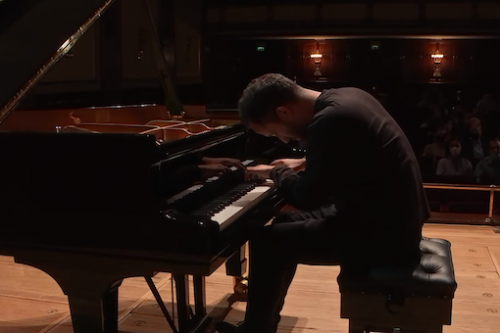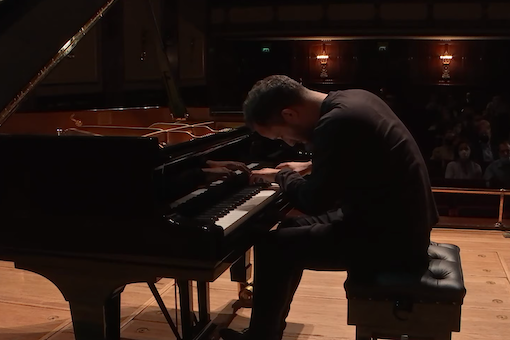 United Kingdom Beethoven, Igor Levit (piano): 16.9.2020 performance live streamed from the Wigmore Hall, London. (JB)
United Kingdom Beethoven, Igor Levit (piano): 16.9.2020 performance live streamed from the Wigmore Hall, London. (JB)

Beethoven – Piano Sonata No.1 in F minor Op.2 No.1; Piano Sonata No.12 in A flat Op.26 ‘Funeral March’; Piano Sonata No.25 in G Op.79; Piano Sonata No.21 in C Op.53 ‘Waldstein’
Ludwig van Beethoven, he who was born in 1770 and died in 1827, became deaf, was said to have been gruff, uncongenial, antisocial, atheist more than unbeliever, and humourless, isolationist. Rossini took up a collection for the wretch in Vienna.
Some have argued that that was Rossini’s best contribution to music. Igor Levit is possibly among them. Beethoven’s presumed masochism is the clue to his soul. Yes, he did have a soul, though Ludwig remained agnostic about this. All composers have an inner ear which is more powerful than their actual ear. Beethoven’s obsessive search to connect with his innermost ear defines the music he has left, especially in the late opuses.
Mr Levit would negate that especially in the late opuses. He shows us that Beethoven was a master of precision whose genius was also very much present in his earliest compositions. The soul will take care of itself if you will only focus on the minutiae of the structure, is what Levit demonstrates. And how he delivers it! Beethoven has never been heard like this.
To the minutiae ladies and gentlemen!
The opening arpeggio-d home chord of the F minor sonata, Op.2 No.1, wings upwards into a stratosphere which might be taking us anywhere. Levit is skilled in creating assured stratospheres and taking us with him. This one is brisk. Calculated, but with a feeling of improvisation too. The whole movement is one to a bar. That doesn’t half keep it moving!
The Adagio is cantabile, but its song is bitter-sweet. A hugely talented young pianist friend told me the other day that he enjoyed playing Beethoven’s chamber music. But he is frightened by the piano sonatas. He then used an interesting metaphor. He said he didn’t have the metabolism to digest these sonatas. This is precisely Levit’s strength: he regurgitates the music which passed so successfully through his gut. We, the audience, then get there through the courtesy of his generosity. Enjoy too the startling simplicity of the final two pianissimi chords.
Simplicity again for the third movement. But this struggling to become a minuet is not the ‘light fantastic’: it has become steely.
Aggression rears in the finale. But it also sings in its haste. This also makes for an alternating dialogue between assertion and reflection. Hands up those who thought that this structure belonged only to late Beethoven.
The A flat sonata, Op.26, shows Maestro Levit to be an excellent midwife. The Andante is a set of variations with each variation brought gently into this world by a surgeon of astonishing skill. Being born. Keeping the babies gently moving. Variation 3 is my favourite. He, she or it – the identity is studiedly kept a secret – sounds like the pianist has somehow got inside the piano and instead of the instrument’s hammers hitting the strings, they are plucking them pizzicato. Igor Levit introduced these sounds into the piano.
The Scherzo (joke) says Beethoven, should be allegro molto (very lively) There is a sense of humour too, but in Levit’s telling, it is pretty grim. The contrasting trio section is quieter. And calmer too.
Then comes a Maestoso andante (natural nobility) for the Funeral March for a Hero. But Beethoven tore off the dedication when Napoleon became tyrannical. More variations here which lead into the final Allegro which runs helter-skelter with lots more of the left hand pizzicato. And left hand darting over the right. Plumbing on an industrial scale.
There are further hand-crossing feats in the light-hearted G major sonata, Op.79, sometimes called the sonatina, evokes great charm – a quality not usually associated with Beethoven. He does sound as though he is having a bit of fun here. And why not? The Andante is played slower than it sometimes sounds. The Vivace finale is a series of musical questions and answers with a hint of Beethoven humour thrown in. But lightly.
The C major sonata, Op.53, is dedicated to Beethoven’s patron, Count Ferdinand von Waldstein. This is a firm favourite of many pianists including Chopin.
In the opening Allegro con brio, the brio (brightness) overtakes the allegro (liveliness). This is just the kind of nuance where Igor Levit scores higher than others. The minutiae to crown all minutiae.
As an Introduzione the short Adagio molto (very solemnly) morphs into a Rondo (a recurring theme with intermediary musical references to contrast and so illuminate the main theme.) It’s another wonderous Levit achievement how each of these appearances of the rondo motif arrives with the freshness of spring. At first the theme sounds boxed in, but soon it takes wing, whereon there is some assertion which yields to some thunderous bullying. The bells of heaven ring out in determined defiance. No wonder this metamorphosis is so loved by pianists.
I was prompted by one of those YouTube reminders that appear in the margins. to hear this Beethoven sonata played by younger brother Lucas, of the Jussen Netherlands duo, (his slightly elder brother is Arthur) who are best known for the finest ever account on record of the Schubert F minor Fantasia. Lucas playing Beethoven, acquits himself to stand alongside the great Levit. These Jussen triumphs were recorded at Festivals in South Korea where the audience have the awesome respect of a cathedral church service. A number of critics have commented on Lucas’s concentrated, eyes-closed handsomeness being the only eventual distraction from his moving Beethoven performance! Whatever Ludwig van would have said about this is not clear.
Igor Levit was called back for an encore of what would be a UK premiere of his collaboration with American composer and jazz pianist, Fred Hersch (b.1955) whose inspiration came from the sounds and sights of trees in his garden. That being the title of the composition. However, this new piece chimes with Beethoven thinking whereby it is left for each member of the live audience or indeed those watching at home to decide for themselves. Trees had a distinctly John Cage touch.
Catherine Bott did a splendid job as the presenter of the live stream, delightfully informed and informing, enhanced by her melodious speaking voice. Enthusiasm therein, as beautifully measured as Beethoven’s.
The Wigmore Hall’s Autumn concerts are the brainchild of its Director, John Gilhooly, whose imagination and tireless energies have given London its finest ever chamber music season. Long may John reign! Check the Wigmore Hall website for their concerts, available online in your own home. And free, but with the possibility of contributing to their considerable costs by donation.
Jack Buckley
To see Igor Levit’s performance click here.
